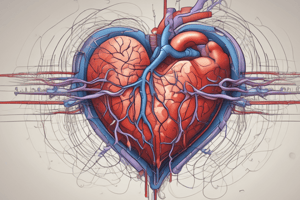Podcast
Questions and Answers
What is the primary source of electrical signals in a normal heart?
What is the primary source of electrical signals in a normal heart?
- Atrioventricular node
- Sinus node (correct)
- Ventricular node
- Coronary node
What happens to the heart chambers during atrial fibrillation?
What happens to the heart chambers during atrial fibrillation?
- The atria beat chaotically and irregularly. (correct)
- The heart rhythm stabilizes.
- The atria and ventricles beat in sync.
- The ventricles stop contracting.
Which of the following is NOT a potential complication of atrial fibrillation?
Which of the following is NOT a potential complication of atrial fibrillation?
- Heart attack (correct)
- Blood clots
- Stroke
- Heart failure
What is a common treatment option for atrial fibrillation?
What is a common treatment option for atrial fibrillation?
What symptoms may indicate the presence of atrial fibrillation?
What symptoms may indicate the presence of atrial fibrillation?
What role does the sinus node play in the heart's function?
What role does the sinus node play in the heart's function?
Which of the following can increase the risk of stroke in individuals with atrial fibrillation?
Which of the following can increase the risk of stroke in individuals with atrial fibrillation?
What is the typical resting heart rate range for a healthy heart?
What is the typical resting heart rate range for a healthy heart?
How does atrial fibrillation affect the heart's rhythm?
How does atrial fibrillation affect the heart's rhythm?
What lifestyle habits could potentially trigger an episode of atrial fibrillation?
What lifestyle habits could potentially trigger an episode of atrial fibrillation?
Flashcards are hidden until you start studying
Study Notes
Atrial Fibrillation (AFib) Overview
- AFib is characterized by irregular and often rapid heart rhythm, resulting from chaotic electrical signals in the heart's upper chambers (atria).
- The heart typically beats due to signals generated by the sinus node, traveling to the atrioventricular (AV) node, and then to the ventricles.
- In AFib, multiple disorganized signals occur in the atria, causing them to beat out of sync with the ventricles.
Symptoms and Risks
- Many individuals may experience no symptoms; however, symptoms can include a fast or pounding heartbeat, shortness of breath, and light-headedness.
- AFib can lead to serious complications including blood clots, increasing the risk of stroke and heart failure.
Heart Function in AFib
- The heart's resting rate is usually between 60 and 100 beats per minute; during AFib, the rate can range from 100 to 175 beats per minute.
- The chaotic signaling leads the atria to tremble while the AV node is overwhelmed with signals, resulting in an irregular heartbeat.
Causes and Triggers
- A range of heart conditions can cause AFib, including heart surgery, stress, and other underlying heart diseases.
- Some patients may experience AFib without any evident heart disease.
- Lifestyle factors that may trigger AFib episodes include excessive alcohol consumption, obesity, and sleep apnea.
Complications
- Blood clots are a significant complication and can lead to stroke; the risk increases with age.
- Other health conditions that heighten stroke risk in AFib patients include hypertension and diabetes.
Treatment Options
- Treatment may involve medications, electrical cardioversion (shock therapy to restore normal rhythm), and procedures to block faulty signals.
- Blood thinners are often prescribed to prevent stroke by reducing the risk of blood clots.
Lifestyle and Prevention
- Implementing heart-healthy lifestyle changes can lower the risk of developing AFib and heart disease, including regular exercise, a balanced diet, and avoiding smoking.
Importance of Medical Attention
- Individuals suspecting AFib symptoms should consult a healthcare professional, particularly if experiencing chest pain, which could indicate a heart attack.
Studying That Suits You
Use AI to generate personalized quizzes and flashcards to suit your learning preferences.



